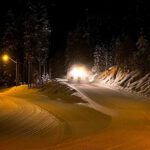Home »

Boat-Busting in Burma
By Elinor Florence
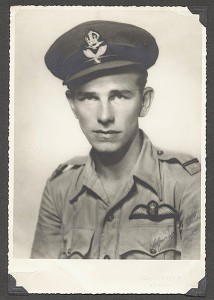 Jim Ashworth of Invermere yearned to fly fighter planes, so when the Royal Air Force ordered him to become a flight instructor, he deliberately failed the test – twice!
Jim Ashworth of Invermere yearned to fly fighter planes, so when the Royal Air Force ordered him to become a flight instructor, he deliberately failed the test – twice!
His plan worked. He was sent to India, where he flew his Hurricane 11D fighter over occupied Burma, strafing Japanese supply boats.
Although Jim turned 96 in April, his memories of those long-ago days flying over Burma with RAF 20 Squadron are crystal clear. In fact, I’ll bet Jim could still fly his Hurricane today; he is that sharp! Here’s a photo of Jim and his wartime photo album.
It was always Jim Ashworth’s dream to fly a fighter plane. But the road from British Columbia to Burma was a long one.
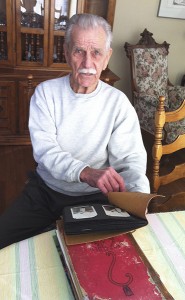
Born in Cranbrook on April 13, 1919, Jim grew up in Invermere, where his father was a bank manager. He moved back to Cranbrook where he finished high school in 1939.
After graduation Jim worked for Kootenay National Park as a gatekeeper and enlisted in the RCAF in January 1941.
He made the usual rounds – Manning Depot in Brandon, Manitoba; Initial Training School in Regina, Saskatchewan; Elementary Flight Training School at RCAF Sea Island (now Vancouver International Airport); and finally Claresholm, Alberta, where he completed Service Flight Training School in September 1941.
After bidding goodbye to his parents and three sisters, he was shipped overseas to Bournemouth, England, assigned to the Royal Air Force and dispatched to RAF Staverton in Gloucestershire.
That’s where he ran into his first roadblock.
The RAF wanted him to become an instructor. But Jim wanted to become a fighter pilot, flying operations against the enemy.
He wasn’t the only one. A small group of Canadians was stubbornly resistant to being relegated to the classroom. But the RAF had limited operational training facilities, and their sympathy for the Canadians was limited.
“Too many Canadians were considered colonials,” Jim said. “That attitude was still very present in the RAF when we arrived. It started to change later as the Canadians proved themselves.”
So Jim took the only other option – he went through the motions at the Flight Training School in Staverton, then deliberately failed the instructor course. The other Canadians followed suit.
The RAF informed them to cool their heels for three months, and then retake the test. Unsure what to do with these recalcitrant Canadians, the RAF transferred them to RAF Kidlington, near Oxford, and assigned them to train as glider instructors instead. Their responsibility was to teach army pilots how to fly gliders in preparation for invading the continent.
“An aircraft with engines towed you along, you glided in and landed on a flat field,” Jim said. “All I could think of was ‘What the hell am I doing without an engine up front?’ We were a thoroughly dissatisfied bunch.”
Jim said they were envious of the pilots who were towing the gliders – the guys with the engines – many of them Polish pilots who had participated in the Battle of Britain.
“To be sidelined like that was bitterly disappointing. And we had very poor living conditions. That winter we slept in a Quonset hut that was so cold I wore my teddy bear flying suit to bed every night for warmth!”
In spring 1942, it was time for Jim and the others to retake the instructor’s test. Not surprisingly, they failed again.
“When I came out of the aircraft, my buddy from Edmonton was waiting to take his test and he asked me what I had done to fail. I told him I hadn’t put the patter together. So then he knew what to do in order to fail!”
Patter was the term used for the verbal instructions that the flying instructor gave the student who was at the controls. Communication between the instructor and the student was obviously very important.
“Quite a few of us failed. We were rebellious young guys, not openly. But amongst ourselves, we were determined that we would never become instructors.”
Their persistence finally paid off. Imagine their delight when the RAF transferred Jim and his buddies to an Advanced Flying Unit for pilots, in Peterborough, Cambridgeshire.
“That was a happy move,” Jim said. “We knew we were finally on the right trail.”
Jim started training on Miles Masters, then upgraded to Hurricanes. The Hawker Hurricane was a classic single-seat fighter aircraft, designed and built for war, and much loved by its pilots. Jim graduated from No. 55 Operational Training Unit in Annan, Scotland in July 1942.
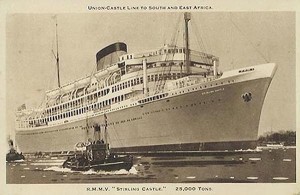 Next stop: India. Jim boarded the Stirling Castle (right) on October 26, 1942 and set out on a long sea voyage.
Next stop: India. Jim boarded the Stirling Castle (right) on October 26, 1942 and set out on a long sea voyage.
“We knew where we were going when they issued our summer kit, but not which squadron. We were going out to replace some pilots who had gone down on an aircraft carrier sunk by the enemy.”
The ship took a circuitous route to avoid the dreaded German wolf packs, the submarines that were wreaking havoc with Allied ships. It sailed from Liverpool to Bermuda, then to South America, and then straight across the Atlantic to South Africa, and finally docked in Bombay on December 18, 1942. Jim had been at sea for six long weeks.
After reaching dry land, he spent a few days at a transit camp and travelled by train to Perulia on New Year’s Eve 1942, where he was assigned to fly with RAF 20 Squadron. This was termed an “army co-op” squadron because it was there to support the Fourteenth Army.
“The first thing we saw on the runway were Lysanders, and that was the last thing we wanted to fly,” Jim said.
Lysanders (called “Lizzies”) were not up to par with Jim’s beloved Hurricanes. But happily the squadron upgraded to Hurricanes (“Hurries”) by the time he started flying.
No sooner had he arrived than Jim had another setback – a double hernia that required immediate surgery in Bombay. “This was a direct result of carrying heavy loads – we had to pack around our parachutes and all our other gear on our backs.” Following surgery, he developed a blood clot that sent him back to hospital.
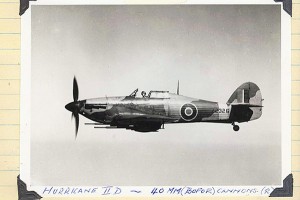
But finally, the long-awaited day arrived when Jim was able to board his Hurricane 11D and start flying operations against the enemy.
The Japanese had occupied Burma, and Jim was stationed on the south coast of India at a station called Chiringa, close to the Burmese border. “We took off and landed right on the beach. They laid down chain link fence on the sand to stabilize it. It worked very well.”
The Fourteenth Army needed all the help it could get, since it was engaged in vicious jungle warfare with the Japanese.
Jim explained: “Much of our scramble action depended on the army liaison officer. He provided us with the targets, shown as coordinate pinpoints on maps. Many of these were unseen targets in thick jungle. Others were tanks, gun emplacements, vehicles and steamers.”
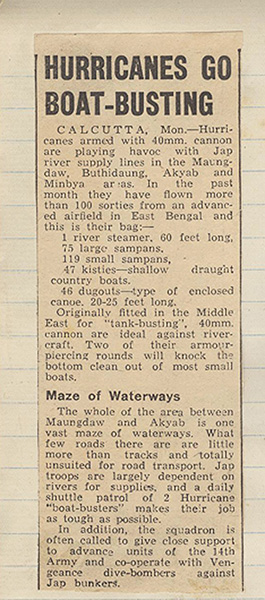
The Hurricanes were called “tank-busters” for the efficient way they could take out advancing tanks, but in Burma they were also known as “boat-busters.”
“The Japanese were using the Kaladan River to freight their supplies and equipment. Our mission was to fly low down the river, usually in pairs. If we saw any ships we would fire on them. We were careful not to hit any sampans being used by the Burmese, who were friendly towards us.
“To try to bring us down, the Japanese strung steel cables across the Kaladan River at various points, which were a major concern.
“We also watched the roads, and fired on tanks, transport vehicles, anything that looked military in nature.”
Jim said two of his major successes were a large river steamer near Akyab, and an important fuel supply depot east of the village.
“We had two 40-millimeter cannons mounted under the aircraft, with high-explosive shells,” Jim said. “They were so powerful that when we fired them the recoil would slow us down by about 15 knots.”
To protect the pilots, armour plates were added to the radiator, motor and under the seat. However, this added weight made the Hurricane more difficult to maneuver. Several pilots were killed when trying to pull up in mountainous terrain.
They didn’t have much room. Most of the missions were flown at less than 5,000 feet, sometimes as low as 100 feet. “Probably even lower,” Jim said. “When you spotted something you wanted to take out, you had to get right down there.”
Jim was stationed close to the front. “That was good in one way because we didn’t have far to fly,” said Jim. “The Hurricane had enough fuel for about two hours and thirty minutes, so all my missions were less than that, although I cut it pretty close a few times.”
On one occasion, Jim and his “number two” – the pilots flew in pairs – were returning from a mission in southwest India when their radio communication failed with their home base of Poonad.
“We were above the clouds over the western Ghats (mountain range) looking for an opening. You couldn’t just drop down to take a look because you might fly straight into a mountain. Finally, we dropped below 800 feet and commenced with a small square pattern search, looking for a clue as to where we were. Nothing.
“We eventually ran so low on fuel, that we had to come down. That was a close call. Fortunately we were able to put down in a rice paddy.
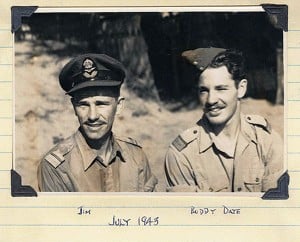
“I hired a couple of Indians to guard the aircraft, and we walked into the nearby village and sent a telegram to home base, and they sent out somebody with extra fuel.”
Living conditions were poor, and food rations were short. Weather, too, was always a factor in such a hot climate. “We couldn’t fly at all during monsoon season, and there were some very serious thunderstorms.”
The squadron was also called upon to deliver food during the siege of Imphal, in northeast India. The Japanese army attempted to invade India, but was driven back into Burma with heavy losses. For weeks the Allied forces at Imphal were surrounded and cut off. The battle of Imphal is still considered to be the turning point on the Southeast Asian front.
“Everything had to be flown in,” Jim said. “My squadron based south of Chittagong provided four aircraft, rotating three to four weeks, depending on weather. Our members packed as much food as we could carry into our small aircraft and landed inside enemy territory.”
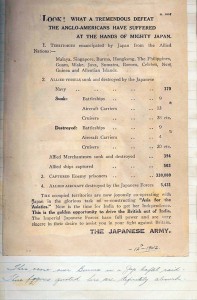 The squadron was also called upon to drop leaflets behind enemy lines, rallying the Burmese people to resist the enemy. The Japanese were doing the same thing, dropping leaflets on India. Here’s a leaflet from “Mighty Japan” in Jim’s album.
The squadron was also called upon to drop leaflets behind enemy lines, rallying the Burmese people to resist the enemy. The Japanese were doing the same thing, dropping leaflets on India. Here’s a leaflet from “Mighty Japan” in Jim’s album.
(Left) is a note in his own handwriting: “This came over Burma on a Jap Leaflet raid. These figures quoted here are definitely absurd.”
Mostly, however, the pilots were trying to eliminate the enemy, often in very dangerous circumstances. “The Japanese were doing their best to shoot us down with their anti-aircraft guns and they often succeeded,” Jim said. “One week we lost seven guys.”
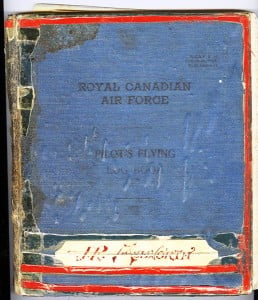
Jim’s best week was in June 1944 at Imphal. “I remember looking down the barrel of a big 105-millimetre anti-aircraft gun, while I was strafing their gun placements along the Tiddim Road. That was pretty frightening.
“But I was successful against a cruiser tank and several tankettes in the Bishenpur-Moirang area. It was an important mission to open the Tiddim Road, and we did it.”
Soon afterwards Jim came down with malaria and returned to hospital.
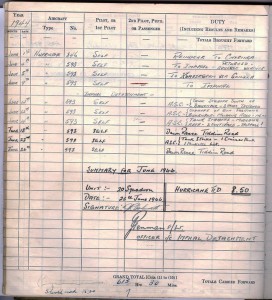
While there, one of his friends went out to the Tiddim Road, found the tank that Jim had destroyed, and removed the identification plate for a souvenir.
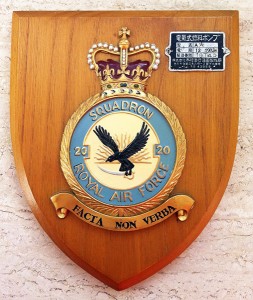 Here is Jim’s RAF 20 Squadron Crest, with the Japanese tank plate bolted to the top right corner. The rising sun commemorates the unit’s long association with the East. The eagle is perched on a Talwar, a curved sabre indicative of the squadron’s work with the army in India. The squadron’s motto: Facta Non Verba means “Deeds, not words.”
Here is Jim’s RAF 20 Squadron Crest, with the Japanese tank plate bolted to the top right corner. The rising sun commemorates the unit’s long association with the East. The eagle is perched on a Talwar, a curved sabre indicative of the squadron’s work with the army in India. The squadron’s motto: Facta Non Verba means “Deeds, not words.”
Jim’s bad luck continued.
The day after he was pronounced free of malaria, he came down with dengue fever, another infectious tropical disease.
That was the end of Jim’s operations against the enemy. After 18 months in India and more than 50 missions to his credit, he was sent back to England, this time through the Suez Canal. He then sailed to New York, and caught the train home to Canada.
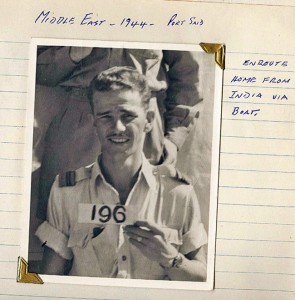
This wasn’t, however, the end of his career in the Royal Canadian Air Force. He accepted a permanent commission and did not retire until 1966, after more than 25 years of service.
His peacetime missions included Western Air Command and Northwest Air Command in Edmonton. He served as the Commanding Officer at RCAF Tofino from 1953 to 1956, then the 425 Fighter Squadron (CF100s) in St. Hubert, Quebec from 1957 to 1959.
From there he went to Colorado Springs, Colorado from 1959 to 1962.
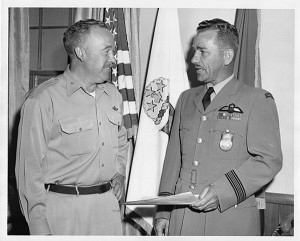 Here he is, receiving a Certificate of Achievement for Services Rendered at NORAD (North American Aerospace Defence Command) from Brigadier-General McColpin of the U.S. Air Force at NORAD Headquarters on July 13, 1962.
Here he is, receiving a Certificate of Achievement for Services Rendered at NORAD (North American Aerospace Defence Command) from Brigadier-General McColpin of the U.S. Air Force at NORAD Headquarters on July 13, 1962.
Jim wound up his air force career at Air Force Headquarters in Ottawa, from 1963 to 1965. It was here that he met with wife Gaetane, who was from Montreal.
After leaving the air force, the Ashworths moved back to the Columbia Valley and together with Jim’s sister Fran and her husband Jack Jeffery, operated the Hoodoo Resort, service station, store and campground near Fairmont Hot Springs. They have one daughter Valerie, who lives in Courtenay.
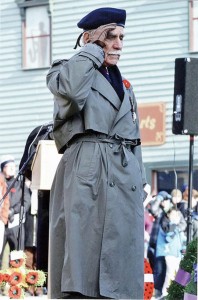
In 2009 Jim and Gaetane moved into Invermere, where they still live in their own home. His sister Fran Jeffery also lives in Invermere. Two other sisters — Evelyn Wannop, who served as a member of the RCAF Women’s Division, and Margaret Foreman – are deceased.
Jim is often seen at Royal Canadian Legion and Remembrance Day events, when he speaks to local school students about his wartime experiences.
Jim, thank you so much for defending our country so well, and for sharing your memories with us. And a very happy 96th birthday to you on April 13!
*All photos and text copyright Elinor Florence.
ABOUT ELINOR FLORENCE
 Career journalist Elinor Florence, who now lives in Invermere, has written for daily newspapers and magazines including Reader’s Digest. She writes a regular blog called Wartime Wednesdays, in which she tells true stories of Canadians during World War Two. Married with three grown daughters, her passions are village life, Canadian history, antiques, and old houses. You may read more about Elinor on her website at www.elinorflorence.com.
Career journalist Elinor Florence, who now lives in Invermere, has written for daily newspapers and magazines including Reader’s Digest. She writes a regular blog called Wartime Wednesdays, in which she tells true stories of Canadians during World War Two. Married with three grown daughters, her passions are village life, Canadian history, antiques, and old houses. You may read more about Elinor on her website at www.elinorflorence.com.
 Elinor’s first historical novel was recently published by Dundurn Press in Toronto. Bird’s Eye View is the only novel ever written in which the protagonist is a Canadian woman in uniform during World War Two. The heroine Rose Jolliffe is an idealistic Saskatchewan farm girl who joins the Royal Canadian Air Force and becomes an interpreter of aerial photographs. She spies on the enemy from the sky and makes several crucial discoveries. Lonely and homesick, she maintains contact with Canada through letters from the home front.
Elinor’s first historical novel was recently published by Dundurn Press in Toronto. Bird’s Eye View is the only novel ever written in which the protagonist is a Canadian woman in uniform during World War Two. The heroine Rose Jolliffe is an idealistic Saskatchewan farm girl who joins the Royal Canadian Air Force and becomes an interpreter of aerial photographs. She spies on the enemy from the sky and makes several crucial discoveries. Lonely and homesick, she maintains contact with Canada through letters from the home front.
The book is available through any bookstore including Lotus Books in Cranbrook, and also as an ebook from any digital book provider including Amazon, Kindle and Kobo. You can read more about the book by visiting Elinor’s website at www.elinorflorence.com/birdseyeview.







